I’m in several groups on Facebook for puppy/dog training advice, and especially with the current pandemic in place I’ve seen a huge uptick in the number of posts that read “Help! My puppy bites a TON. More than the normal amount, he’s totally a shark!” When we see pictures of puppies, we see fluffy fur, big adorable eyes, oversized paws, and soft tummies. What the pictures usually don’t show is that puppies often explore and interact with the world teeth-first.
There are multiple reasons why puppies bite, and knowing the reason why a puppy is biting in a specific situation can help to develop a plan to reduce or eliminate biting in that situation. As with all behavior modification, two parts are required: training and management. We can work all day long on teaching our puppies not to bite, but if their environment doesn’t set them up for success progress will be slow and/or incomplete. Puppies will bite for different reasons at different times (or sometimes different reasons at the same time!), so keep in mind that there can be multiple things in play at once.
Reasons why puppies bite:
Boredom/attention seeking:
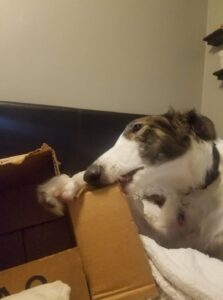
Oliver the Borzoi chomps a cardboard box, they’re very fun to chew!
If your pup is biting because he is bored or understimulated, make a note of it for next time, look for ANY calm/good behavior, and reward with play. In the future, make it your goal to predict when the pup will start to get bitey (like if it happens every day at 6pm), and do a nice play or training session BEFORE the bitey-ness starts. I will sometimes redirect to a toy but try not to make a habit of it, as I don’t want my dogs to learn that if they bite me, a fun play session might start up. You want to build good habits of relaxing so that even if the pup doesn’t get all the stimulation he needs, he’ll learn in the future that relaxing gets rewarded (sometimes).
One behavior I do make a pretty big effort to work on with young puppies for a multitude of reasons is tugging on an appropriate toy, and with appropriate manners. Tug is a great way to get out a puppy’s need to put their teeth on things, teach them what types of things to seek out when they want to bite stuff, practice “drop it” and reinforce with food or more play, get energy out, and build up tug as a reward/motivator. Despite the longstanding myth, tug will not make a dog aggressive, especially when played “by the rules.” There’s a reason why most high level sports trainers use tug as a reward frequently – it builds lots of enthusiasm and focus on the handler. I will make a video in the future on how to play tug with safe rules and post it here when it’s available.
Something that CAN count as an attention seeking biting/chewing related behavior in some puppies is picking up random stuff in the yard like sticks, leaves, rocks, etc. Unless the item they have is toxic and they are in immediate danger, I find that ignoring this behavior is the quickest way to make it a nonissue. If dogs learn that they can tempt their owners into a super awesome game of keep away by snatching a piece of bark and starting to chew on it, they’ll be more likely to grab stuff on the ground when they want your attention. Keeping toys in the yard can help, but actually playing interactively with toys in the
Overtired:
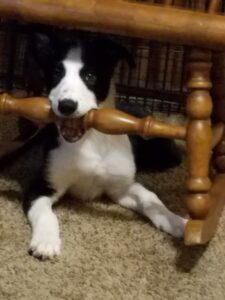
Archie the Border Collie bites a wooden chair, most likely seeking attention and the enjoyment of chewing wood
Young puppies need about 18 hrs of sleep per day. That only leaves 6 hrs of awake time! If your puppy has been awake for 3+ hours and is starting to get bitey, he’s probably overtired. This is a great time to put him down for a nap in his crate or exercise pen. Usually for puppies that get extra bitey around 6-7pm (aka “puppy witching hour”), the cause tends to be overtiredness. With young puppies, my usual rule of thumb is that for every 1-2 hours of being awake, they need about 2-3 hours of sleep.
If you are crate training, this is a great time to utilize the crate as a nap zone. If you are not, you can put your pup in an exercise pen or gate him off in a room like a kitchen/laundry room/bathroom where he can’t get into much trouble (just make sure to pick up exciting treasures like toilet paper rolls, shoes, and garbage cans).
Hungry/thirsty/bathroom:
These are biological needs. With hunger and thirst, wait for some good behavior and then meet the need (if it’s close to meal time, water should be available freely though during the day when puppies aren’t crated). For dogs that go wild at mealtimes, work on impulse control exercises with food during training times, and manage during meal prep. I usually feed in the crate when my puppies are young, so instead of fixating on me/trying to jump at me while I’m prepping food, they wait where they know the food is about to show up – the crate.
With needing to go out to the bathroom, take out ASAP before the pup has an accident but teach a more appropriate signal for the future so he can let you know he needs to go without biting. I teach young puppies that any time they stand/walk near the door to the outside, they’ll get a bathroom trip (whether I think they need one or not). They start to learn that they can make me get up by standing by the door, and that I get pretty excited when they go to the bathroom outside.
Request for space:
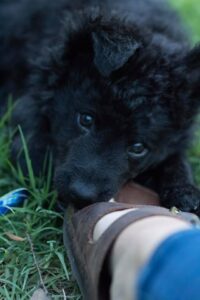
Qatar the Mudi nibbles a shoe, likely as a play solicitation
When we try to do things that our puppies don’t like, such as brushing, nail trimming, or cuddling when they’re rowdy, many puppies will show their displeasure by biting. If biting successfully makes the interaction stop, that’s very reinforcing for the dog and he will likely learn that if they want to get out of something in the future, they can do so by biting.
With this, we don’t want to reinforce the biting, and we also ideally want to be able to do things like brush, trim nails, and cuddle our dogs. Making sure to time when you work on handling/grooming exercises and cuddle time for when your pup is emotionally/mentally satisfied and tired but not overtired will make things go much easier. Go slow and make things fun for your dog, forcing things will make for slower progress, less trust, and more resistance.
Teething:
Puppies typically have all of their puppy teeth by the time they go home at 8+ weeks, and don’t usually start losing teeth until 4.5 months or so. While puppies will often put things in their mouth during teething (4.5-6.5 months or so) to stimulate their gums, puppy biting in the 2-4 month range is usually not due to teething as much as it is from other causes.
What to do in the moment if your puppy is already biting:
If your pup is already biting, say “ouch” or something similar, and then if he continues stand up and walk away or move him away from you (like if he’s biting you on the couch, put him on the floor). If he follows you and continues, put him in a confinement area (crate, gated room, or exercise pen) or go into another room and close the door for 20-30 seconds. He will learn that if he continues biting after hearing “ouch,” he will lose access to you (the source of fun).
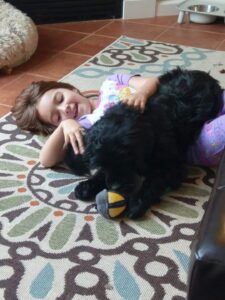
Nimbus the PWD plays with a toy while hanging out calmly with Elsie
With puppies that bite children, management is critically important. Adults can be pretty good at responding to biting with an “ouch” and moving the puppy somewhere else in response to biteyness, but kids tend to do things like scream, fall down, run away, laugh, push the puppy, and other super exciting things that to a puppy look a lot like play. Leashes (either held or dragging) can be an excellent way to manage child-puppy interactions, as can working on calm behaviors around kids like settling on a mat, hand target touches, and working on a chew/stuffed kong. Having puppies out when kids are doing calm things like reading, eating, watching TV, etc. will also help encourage calm behavior, and then you can gradually work up to more exciting activities like running, riding bikes, etc.
This is applicable to everything except biting as a request for space, since this response to that scenario would reinforce that behavior. Usually for space-requesting biting, I will stop what I’m doing but not move away, wait for the biting to stop, then move away. For example with a brush, if the pup turns to bite the brush I’ll keep it where it was, wait for the puppy to stop biting the brush, then put the brush down. I make a note to work on that scenario again when the puppy is more mentally equipped to be successful, and break things down into smaller steps if needed.
What NOT to do if your puppy is biting:
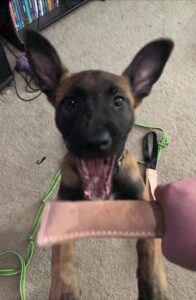
Pinkie Pie the Malinois makes a great choice to bite a leather toy rather than the hand holding the toy
Common traditional advice for biting includes things like holding the puppy’s mouth shut, yelling at them, smacking their snout, spraying them with water, and other unpleasant responses. While these methods “work” for some dogs, they are not particularly kind or fair, and have a high likelihood to backfire and teach pups to be afraid of things like hands and water. Even though it may seem like puppies are “out to get us” sometimes with how they become little furry teeth tornadoes, biting is hardwired into their DNA and not something they have any reason NOT to do in the beginning. Teach appropriate alternatives and manage situations to prevent bad choices, and you will get results.
Setting up for success:
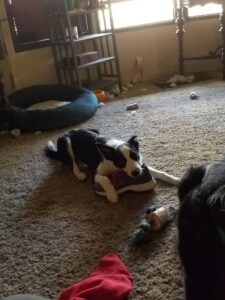 Chewing and biting is a big part of puppy behavior, so make sure your puppy also has plenty of appropriate toys and chews to work on. Some chews I recommend for puppies are bully sticks, cow hooves, stuffed kongs, goat horns, Himalayan yak chews, tracheas, chicken feet, and water buffalo horns. I usually will give softer/more edible chews (tracheas, chicken feet, etc.) during supervised short term chew sessions like when I’m working on crate training or need a distraction while I cook dinner, but leave a few long term chews (water buffalo horns, cow hooves, etc.) out all the time so my puppy has something appropriate available to chew if the need strikes. Always supervise your puppy for safety the first few times you give him a new type of chew.
Chewing and biting is a big part of puppy behavior, so make sure your puppy also has plenty of appropriate toys and chews to work on. Some chews I recommend for puppies are bully sticks, cow hooves, stuffed kongs, goat horns, Himalayan yak chews, tracheas, chicken feet, and water buffalo horns. I usually will give softer/more edible chews (tracheas, chicken feet, etc.) during supervised short term chew sessions like when I’m working on crate training or need a distraction while I cook dinner, but leave a few long term chews (water buffalo horns, cow hooves, etc.) out all the time so my puppy has something appropriate available to chew if the need strikes. Always supervise your puppy for safety the first few times you give him a new type of chew.
Making sure to meet mental, physical, and emotional needs through both chewing and play on appropriate items will also drastically reduce how much puppies feel the need to bite at other times.

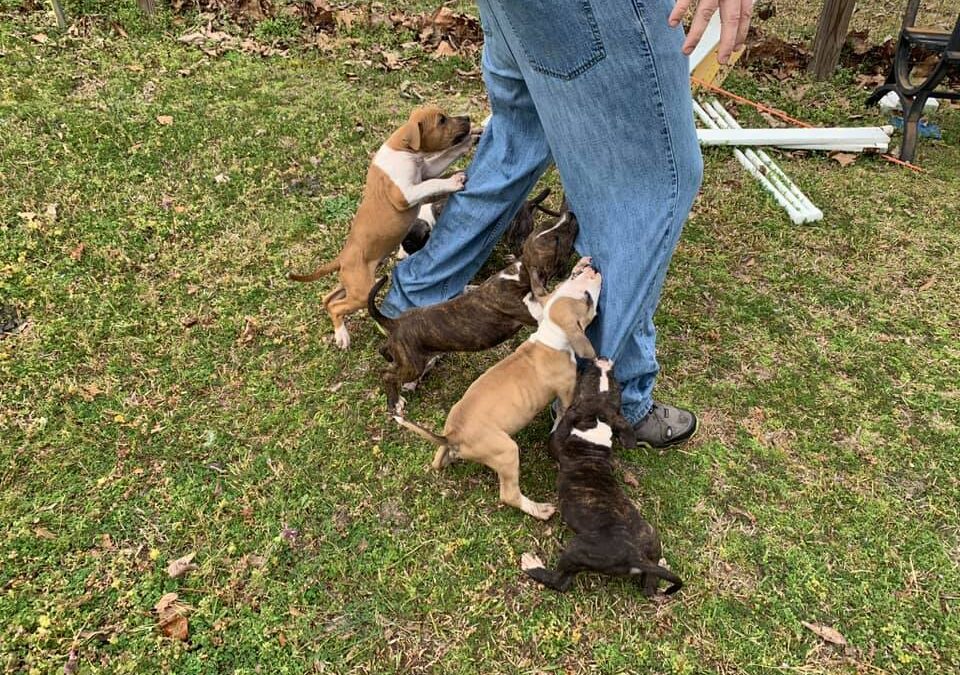
My mini female Dachshund is 4 months old and is biting constantly. I’ve tried all the recommended ways to deal with this, which worked on my other Dachshunds. My vet has
recommended using a muzzle, but I am reluctant to do so. Is this something I should consider?
No, a muzzle is not an appropriate solution for biting with a 4 month old puppy. How much sleep is your puppy getting throughout the day? What types of chews does your pup get on a daily basis? How much training are you working on during the day to teach and reinforce appropriate behaviors?